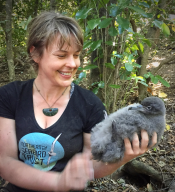Ko Stephanie Borrelle tōku ignoa.  I am a Pākehā (settler-coloniser to Aotearoa New Zealand), and my pronouns are she/her.
I am a Pākehā (settler-coloniser to Aotearoa New Zealand), and my pronouns are she/her.
I tae mai aku tupuna wahine tahi mano waru rau whitu tekau ma wha o Te-whanganui-a Tara. He uri ahau no Hōrana, no Kōtirana, no Pōrana. I whānau mai au i te taha o Ōtautahi, I ngā parenga o te awa o Waimakariri, I raro i te maru o Aoraki maunga. [My great-great-great-grandmother arrived to Wellington, Aotearoa in 1874, my whakapapa traces back to the Netherlands, Scotland and Poland. I was raised in Christchurch alongside the Waimakariri river, under the shadow of Aoraki (Mt Cook).]
A prominent feature of my childhood was spending time in nature, and I was privileged to learn aspects of tikanga Māori (values and practices from matauranga Māori), which informed my worldview towards principles to kaitiaki—guardianship of the whenua, awa and moana (land, rivers, and oceans).
I am a conservation socio-ecologist working at the nexus of science practice, international policy, and the local community level to implement conservation measures to protect seabirds across Te Moananui-a-Kiwa (Pacific Ocean), and globally. I was trained within the western scientific academy in marine biology, environmental science and manu moana (seabirds) conservation in Aotearoa, and currently work on the lands of Te Kawerau-a-Maki, Ngāti Paoa, Ngāi Tai, Te Wai-o-Hua, Ngāti Whātua-o-Ōrākei, Ngāti Whātua, and Ngāti Te Ata.
Aotearoa New Zealand, my home, is the seabird capital of the world – we have 86 species that breed here, 36 are endemic – the highest diversity anywhere! Seabirds are the most threatened group of animals worldwide – a whopping (and unacceptable) 31% risk extinction.
Land-based conservation efforts (such as predator eradication) around the world have improved the conservation status of numerous species (like the New Zealand storm petrel), but threats at sea continue to cause significant declines for many of these captivating birds.
Fisheries bycatch is one of the most critical issues facing albatrosses and petrels around the world. I’d like to do something to change that, and I can through my job as the Marine and Pacific Regional Coordinator for BirdLife International. In this role, I work in collaboration with government, non-governmental organisations, and private industry to end seabird deaths in long-line fisheries through Regional Fisheries Management Organisations (RFMOs).
Seabirds are also disproportionately affected by plastic pollution because of their foraging strategies (feeding at the surface of the oceans). During my David H. Smith Postdoctoral Fellowship, I was based at the University of Toronto (in the Rochman Lab with Associate Professor Chelsea Rochman & Ocean Conservancy), and the University of Georgia, USA with Associate Professor Jenna Jambeck) – two of the world’s leading experts on plastic pollution. The results of my postdoc research were published in Science in September 2020. We evaluated how much effort is needed to meaningfully reduce future plastic emissions into marine and freshwater ecosystems. Our work aims to inform governments, NGOs, businesses, and individuals about the level of effort that we need to put in as a global community to eliminate plastic pollution.
See my research outputs in Publications or at Google Scholar

Hi Steph, glad to see you’ve spread your wings and making and impact over there! I was just reading your paper (Hare et al. RSNZ, Intractable species) and wanted to say what a great piece of work it is.
Thanks very much Susan, that is very humbling. I hope you are well and we get a chance to catch up again soon 🙂